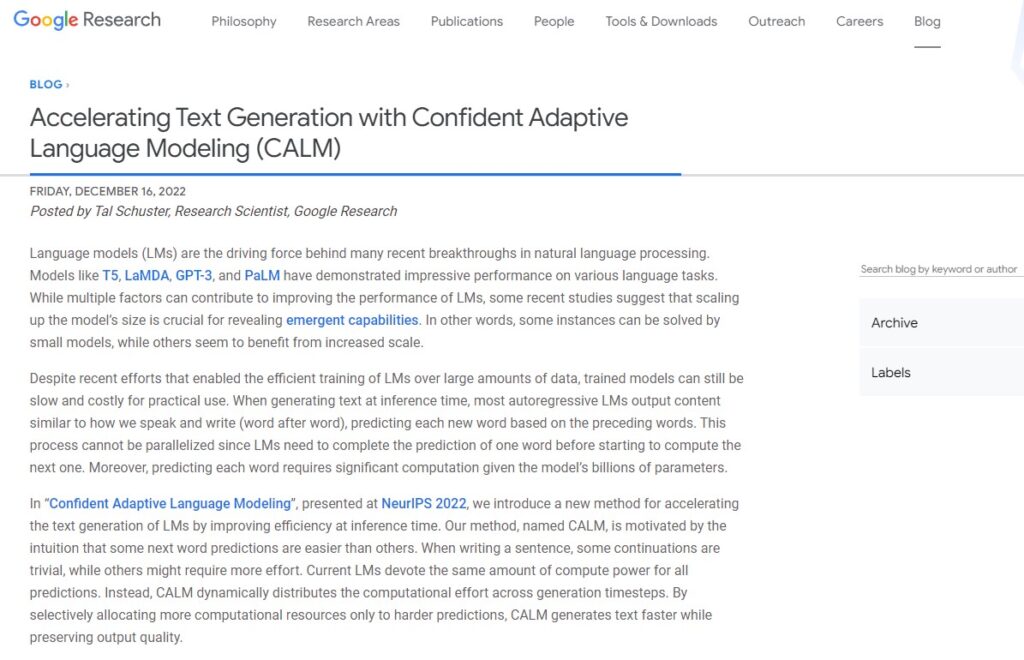As AI continues to evolve, developers and researchers are becoming increasingly reliant on language models (LMs). This form of artificial intelligence can help to auto generate natural-sounding sentences and paragraphs, making it a great tool for content creators of all stripes.
One of the newest forms of language modeling is Confident Adaptive Language Modeling (CALM). In this blog post, I’ll explain how CALM works and the advantages it offers content creators.
What is CALM?
Confident Adaptive Language Modeling (CALM) is a new and advanced form of language modeling from Google AI that uses deep learning to create natural-sounding text.
With CALM, AI algorithms learn from existing data sets and can then generate new content based on that knowledge.
CALM is ideal for generating text quickly and efficiently with minimal effort from the user.
According to a Google Research paper published on 12/16/2022, CALM accelerates text generation by LMs by improving efficiency at inference time.
CALM (Confident Adaptive Language Modeling) is a recent advancements in artificial intelligence technology LMs that has garnered a great deal of interest from AI researchers and data science companies alike.
It combines the use of deep learning techniques, natural language models, and other AI technological advancements to enable machines to understand human language better than ever before.
For starters, CALM enables machines to ‘read’ natural language text more accurately than traditional methods. This means that AI based applications can recognize words and phrases in various languages with higher accuracy and speed compared to the predecessor language models.
As a result of this, Confident Adaptive Language Modeling has the potential to improve search engine performance as well as the general efficiency of communication channels between customers and companies – be it via emails or AI chatbots.

How Does CALM Work?
At its core, CALM relies on a deep learning algorithm called a recurrent neural network (RNN).
RNNs process inputs in sequence and output predictions based on those inputs.
This means that the RNNs can learn patterns in datasets over time and make more accurate predictions as a result. This makes them perfect for use in CALM, which requires predictions that are both accurate and natural-sounding.
When writing a sentence, some continuations are trivial, while others might require more effort. Current LMs devote the same amount of compute power for all predictions. Instead, CALM dynamically distributes the computational effort across generation timesteps. By selectively allocating more computational resources only to harder predictions, CALM generates text faster while preserving output quality.
Quote from ai.googleblog.com on December 16, 2022
Advantages of Using CALM
The primary advantage of using CALM is its speed; with just minimal input from the user, it can generate entire pieces of text in seconds or minutes.
Additionally, because it’s based on deep learning algorithms, it can continually improve its accuracy as more data sets are added to its system over time. Because it utilizes existing data sets instead of relying solely on random words or phrases, its output is natural-sounding and easy to read.
Confident Adaptive Language Modeling (CALM) is a deep learning approach gaining recognition from artificial intelligence companies and data researchers. Google had created the CALM model as a better alternative than other language models for rapid text generation. CALM’s use of neural networks helps the deep learning algorithms quickly understand the relationships between words in text, with a higher degree of output accuracy & efficiency.

Summary: Confident Adaptive Language Modeling
In conclusion, Confident Adaptive Language Modeling (CALM) provides an efficient way for content creators to quickly generate natural-sounding text without having to put too much effort into each piece they produce.
Thanks to its reliance on deep learning algorithms like recurrent neural networks, CALM can learn from existing datasets and make more accurate predictions as a result — ensuring that each piece generated by this AI technology will be both accurate and easy to read.
CALM helps fosters even faster text generation with LMs, while maintaining high quality & originality of the text output. Through dynamic modification of the amount of compute per generation timestep, this allows the language model to exit the computational sequence early with a higher degree of confidence than other language models most commonly used in AI text generation today.
If you’re looking for an effective language model for quick text generation without sacrificing quality or accuracy, then consider developing your AI text generator project using CALM.
FYI, Google is also developing an AI video model using Imagen text to video AI animation technology with its new Imagen Video AI diffusion model.
